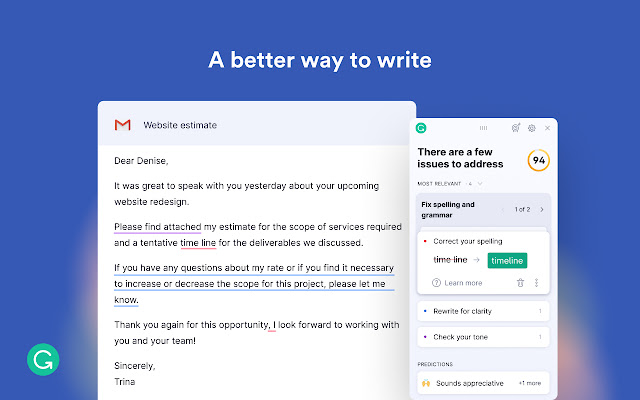Science writing is a difficult business. It requires not just an understanding of the subject matter, but also a mastery of grammar, spelling and clarity. This can make composing a first draft feel daunting and time-consuming. But with the help of artificial intelligence (AI), it is possible to write faster and more efficiently.
There are many AI tools that can help you with your science writing. In this post, we’re going to look at two of them: Hemingway and Grammarly. As well as checking your text for spelling and grammar errors, they will also give you suggestions for how to improve the clarity of your writing by pointing out words or phrases that might be confusing or overly complicated.
Neither tool will write your articles for you (if only!), but they can help you find your way through a thicket of words to express yourself vividly and in a way that engages and inspires your readers—which, at the end of the day, is what really matters.
Hemingway Editor
Hemingway editor is a free online tool that checks for readability and does a word count. It also gives feedback on the number of passive sentences, adverbs, and adjectives. It is named after the novelist Ernest Hemingway, who was celebrated for his clear, simple prose.

So Hemingway isn’t a spellchecker, it’s a style checker: it helps you energise your writing. Our words are too frequently like our thoughts – many and chaotic. Hemingway cuts through the noise and verbosity to make your prose clear, lively and vivid.
It also assesses the “readability” of your writing, using a number of well-established formulas that measure things such as the number of words per sentence, syllables per word, and sentences per paragraph in a text.
The Hemingway Editor automatically calculates a readability score based on the reader’s educational level. It appears as different levels of “grade”, based on the US education system, where grades are equivalent to particular age groups. Grade 5, for example, covers children aged 10-11, and grade 10 is age 14 – 15. Ernest Hemingway’s writing is rated between 4th and 6th grade readability.
If your score is a grade level 9 – 10 or below, your text should be very readable.
How does it work?
Simply go to the website and paste in your text. Hemingway highlights your work using various colours to suggest different ways to improve your prose. Here’s an example taken from George Orwell’s famous essay, Politics and the English Language. The text is deliberately written to be as obtuse as possible. Here’s what Hemingway Editor makes of it:

The AI highlights problems with the text using a colour-coded scheme:
Yellow: Hemingway thinks these phrases are too complicated. Split or simplify yellow-highlighted sentences.
Red: The length or complexity of the language in these sentences may mislead readers. Revise these phrases until they no longer have a red highlight.
Purple: Words in purple may be replaced with simpler, more appropriate alternatives. Click on them to see a tip from Hemingway.
Blue: As adverbs, blue words have a tendency to weaken the impact of your writing. Delete whenever possible.
Green: Passive voice is indicated by green phrases (do you see what we did there?). Despite the fact that the passive may be suitable in certain instances, the active voice delivers more vivid, powerful prose.
Orwell created that turgid text by re-writing a famous phrase from the Old Testament, breaking all the rules of good writing to make his point about the importance of clarity. Here’s what Hemingway Editor makes of the original version:

So better, but still quite complex, with a reading age of Grade 12 (age 17-18), but this is the Old Testament, a formal text. It does, however, meet Hemingway Editor’s approval, if you split the sentences up as follows:

This has a reading age of Grade 4 (age 9-10) and is therefore very “readable”.
How much does it cost?
The web version of Hemingway is completely free to use. For a one-off payment of USD19.99, you can download a desktop version of the app.
Grammarly
Grammarly is a powerful tool for writers who want to make sure that their content is error-free. It can help you produce clear science writing optimised for spelling, grammar, and style.

The AI has an extensive library of words, phrases and expressions to choose from when writing your document. This means that even if you’re not sure how to spell a word or what the correct use of an expression might be, Grammarly will do the work for you.
Grammarly is also capable of providing contextual feedback as you write your text, to provide you with tips on how to improve your sentence structure and word choice. It works across multiple platforms like Microsoft word, Apple Pages, Google docs, email clients and even messaging platforms like Slack.
How does it work?
You can download the app for free on your desktop, laptop or phone. To help you write better on Gmail, Google Docs, Twitter, and everywhere else you write online, Grammarly browser extensions are available.
How much does it cost?
For individual users, Grammarly features a free and a premium plan. For most people, Grammarly’s free option is one of its most appealing features. It has no time limit or trial period, so you may use it as for long as you want.
There are “basic writing tips” in the free plan. Spelling, grammar and punctuation checkers are all included. They’re much more powerful than the ones you’ll find in conventional word processing software.
The tool highlights any errors it finds in red. If you click on the highlighted parts, you get a detailed explanation of what went wrong and how to fix it. You can also click on any red words themselves for clearer explanations of what’s wrong with them.
The free version of Grammarly will find most of the fundamental errors in your writing, as well as suggest terms you may have wanted to use. However, upgrading to Grammarly Premium is required to get all of Grammarly’s capabilities. Everything in the free tier is here, plus seven more features: sentence rewrites aimed at improving clarity, tone modifications, plagiarism detection, word choice, formality level, fluency, and further advanced recommendations.
Grammarly Premium starts at USD 12.00 (about GBP 8.00) a month. So do you need to upgrade? In our opinion, it depends. The free version of Grammarly is a great way to get started with proofreading your work and making sure that you’re not making any mistakes in your writing. If you need some extra help with clarity, style and tone in your science writing, then consider upgrading to premium.
Finally
AI tools like Hemingway and Grammarly can be invaluable for polishing your prose, but don’t forget that they do have limitations. As machines, they lack the creativity and distinctiveness of a unique, human mind. Learning how to write well involves developing your own style and voice as well as following the rules of spelling and grammar.
At SciConnect, we can help you take your science writing to the next level with our range of courses—please click on the button below to find out more.